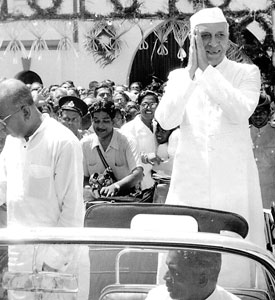Vesak in 1956 marked the start of the Buddha Jayanthi Year, commemorating the 2500th anniversary of the
passing away of Buddha
(543 BC). As part of the
celebrations, the Government invited heads of State,
particularly from Asian
countries to visit Sri Lanka and participate in the numerous
ceremonies. Virtually every month there was a distinguished visitor. May 1957, saw the
Prime Minister of India,
Shri Jawaharlal Nehru visiting
Sri Lanka.
The first Prime Minister of independent India,
Shri Nehru arrived in the island with his daughter Indira (who later became Prime Minister
herself) on May 17. The highlight of his stay was the visit to Anuradhapura, which he did the following day, travelling by
special train.
The 'Jayanthi Mawatha' in the new town was opened by him to mark the Buddha Jayanthi. He also spent time at the Samadhi Buddha statue which he
admitted had brought him solace when he was in prison.
During a previous visit to Anuradhapura Nehru had spent time all by
himself at the Samadhi statue
contemplating).
Liberator of India – Shri Nehru (1889 – 1964)
Jawaharlal Nehru was born in Allahabad on November 14, 1889.
A high caste Hindu, he was educated in England at Harrow, Cambridge University and the Inner Temple where he qualified as a barrister in 1912.
 |
| Shri Jawaharlal Nehru greeting the crowds.
On the left is Minister of Cultural Affairs, Jayaweera Kuruppu. |
In 1920, he joined the nationalist,
non-violent movement led by Mahatma Gandhi and
became a passionate
advocate of Indian
independence. Between 1920 and 1927 he was imprisoned eight times for his political activities. In 1929, he was General Secretary of the
All-India Congress Committee and succeeded his father as President of Congress.
In September 1946, he was appointed
Vice-President of the Executive Council or interim government of India set up by the Viceroy, Lord Louis Mountbatten. Eleven months later he became the first Prime Minister and Minister of Foreign Affairs of the Dominion of India.
Speaking at midnight on August 14, 1947 to a hushed audience in Parliament House, New Delhi, Nehru referred to "a tryst with
destiny." "At the stroke of the midnight hour," he said, "when the world sleeps, India will awake to life and
freedom.
A moment comes which comes but rarely in history, when we step out from the old to the new, when an age ends, and when the soul of a nation, long
suppressed, finds utterance. It is fitting that at this solemn moment we take a pledge of dedication to the service of India and her
people and to the still larger cause of humanity."
In 1962, the Congress party was returned to power for its third five-year term as the Government in India and Shri Nehru continued to be Prime Minister until his death on May 27, 1964. His successor was Lal Bahadur Shastri on whose death in 1966, Nehru's daughter Indira Gandhi became Prime Minister.
Anuradhapura
Anuradhapura, the first capital of Sri Lanka (from the 4th century BC until the beginning of the 11th century AD), became a Buddhist city after the introduction of Buddhism in the 3rd century BC. Buddhism received royal patronage after Arahat Mahinda came over and
established the religion which was readily accepted by the king and his subjects.
Anuradhapura was studded with stupas and Buddha images sculpted in stone. They were works of art which have become symbols of a great civilization. Monasteries were
established with hundreds of Buddhist monks
occupying them and the king providing them with all facilities.
With foreign invasions, Anuradhapura was
abandoned and the royal capital began
shifting from one city to another. The religious edifices decayed and Anuradhapura became a forgotten city in the dry zone. The British administration showed interest in rebuilding Anuradhapura and work in this connection began in the 19th century.
After Independence in 1948, the government paid attention not only to the preservation of the sacred sites but also to remove the commercial operations to a new location. Thus a new town was born and the area with the places of worship was declared a Sacred City.
The Sacred City of Anuradhapura was declared a Heritage Site by UNESCO in 1982. The new town was inaugurated in 1949. |

